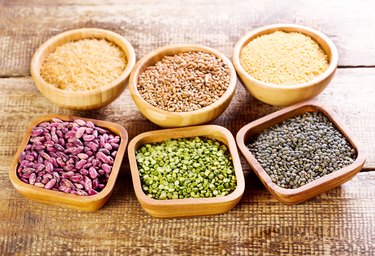
Eggs, meat and milk are the chief sources of protein in the United States and other industrialized countries. Although manufacturers vary the amounts of protein in their products depending on the latest trends, your body always has the same response to protein intake, according to a 2013 report in PLoS ONE. The digestion of protein involves five steps.
Read more: Top 10 Sources of Protein
Video of the Day
Video of the Day
Mouth: Degrading Protein
The initial stage of protein breakdown occurs in your mouth through mastication, or what you may know better as chewing, when your teeth break apart large pieces of food to increase the surface area for easier digestion. Saliva also plays a critical role in the chewing process by acting as a lubricant to facilitate nutrient release and to trigger natural swallowing. The authors of a 2019 report in Food Chemistry speculated that the early release of nutrients sets the stage for later digestive processes.
Stomach: Protein Denaturation
After chewing, you swallow your food and send it to your highly acidic stomach. The acid in your stomach denatures, or unravels, the protein matrix making it more accessible for digestion. Then, your stomach releases a special enzyme called pepsin to start breaking apart the protein string into smaller strings referred to as di- and tri-peptides, as well as amino acids for easier digestion when it reaches your small intestine.
Protein changes occur even in the stomachs of infants. In addition to a digestive role, these changes have a protective role. For example, many of the resultant compounds bolster the immune system. This early creation of protective substances happens because the location of the next stage — the small intestine — has a unique vulnerability.
Small Intestine: Further Breakdown and Absorption
Your small intestine is responsible for two stages of protein digestion, including continued breakdown of the protein and absorption. As the protein travels down your small intestine, protein-specific enzymes from your pancreas continue to degrade the larger protein strings into di- and tri-peptides, as well as amino acids.
Then, the wall of your small intestine absorbs these nutrients and sends them to your bloodstream for transport to the various tissues of your body. The protein from your small intestine is used to restore and repair tissue, make hormones and enzymes, and serve as the building blocks for the creation of bone, muscle, skin and blood.
Large Intestine: Clearing Waste
The final stage of protein digestion occurs in your large intestine. Here, your body absorbs electrolytes, vitamins and water and transmits the unusable waste out of your body. While it's largely recommended that you get all of the essential amino acids from the food you eat, the friendly bacteria found in your large intestine may be able to manufacture the amino acids your body needs for survival from carbohydrate substrates.
Your Response Remains the Same
Scientists have speculated that the food processing and portion size may affect your body's response to protein, and they have discovered two protein types — fast and slow. Meat has many fast proteins that play an important role in muscle synthesis. Yet it remains unknown how cooking affects these proteins and their digestion.
The 2013 report from PLoS ONE evaluated this topic in an animal model. Results showed that important amino acids reach the bloodstream fastest when meat is cooked at 170 degrees Fahrenheit. Yet true digestion remains unchanged by cooking temperature or portion size.
- Frontiers in Nutrition: Animal Models for the Study of the Relationships Between Diet and Obesity
- PLoS ONE: Effects of Meat Cooking, and of Ingested Amount, on Protein Digestion Speed and Entry of Residual Proteins Into the Colon
- Food Chemistry: Mastication-Induced Release of Compounds From Rye and Wheat Breads to Saliva
- Journal of Nutrition: Peptidomic Analysis of Human Milk Digestion in the Infant Stomach Reveals Protein-Specific Degradation Patterns
- Nature Reviews: Adult Intestinal Stem Cells: Critical Drivers of Epithelial Homeostasis and Regeneration
- Biochemistry: Proteins Are Degraded to Amino Acids
- Colorado State University: VIVO Pathophysiology: Prehension, Mastication, Swallowing
- National Institututes of Health: Genetics Home Reference: What Are Proteins and What Do They Do?
- National Center for Biotechnology Information: StatPearls: Physiology, Large Intestine